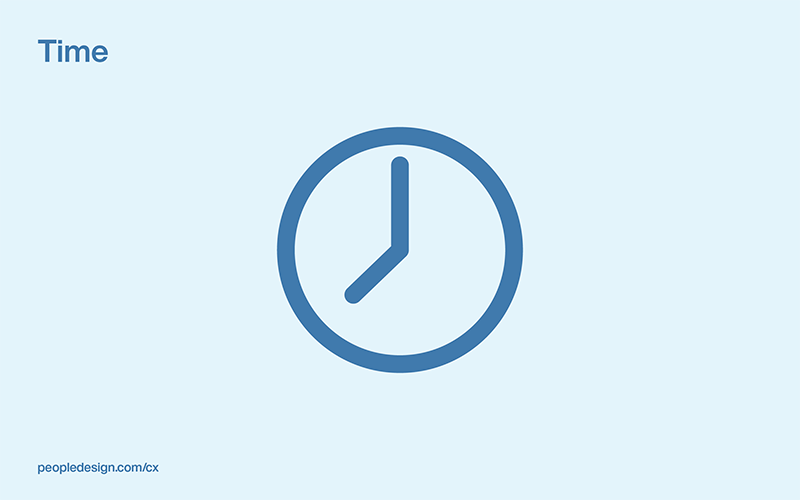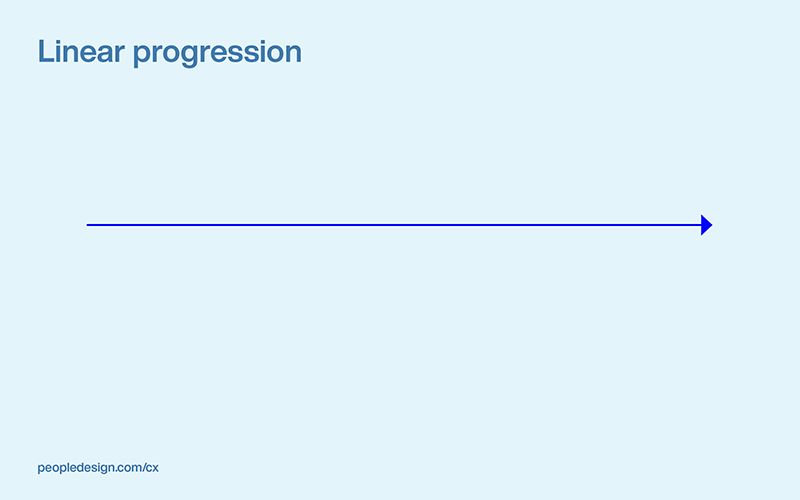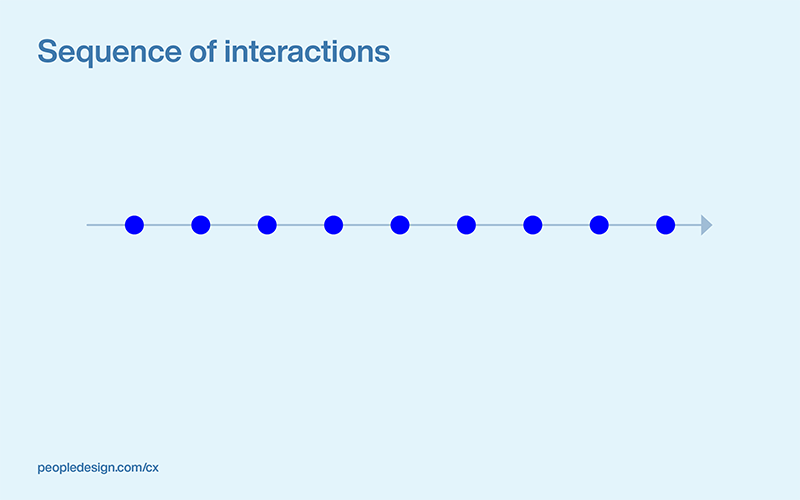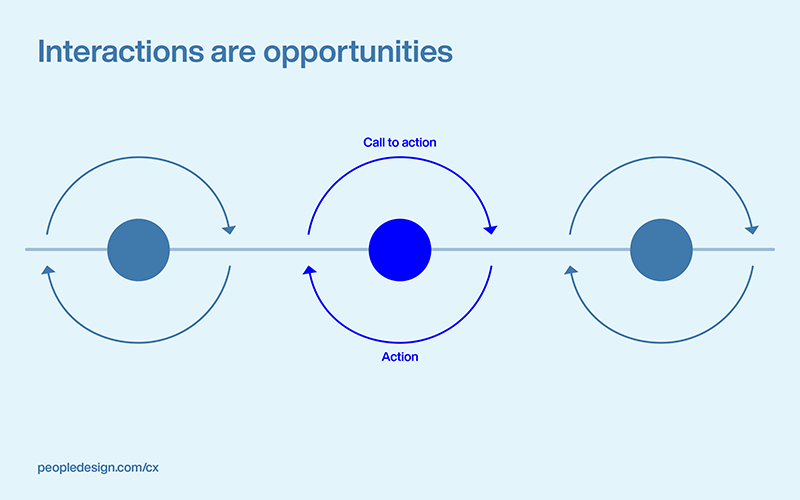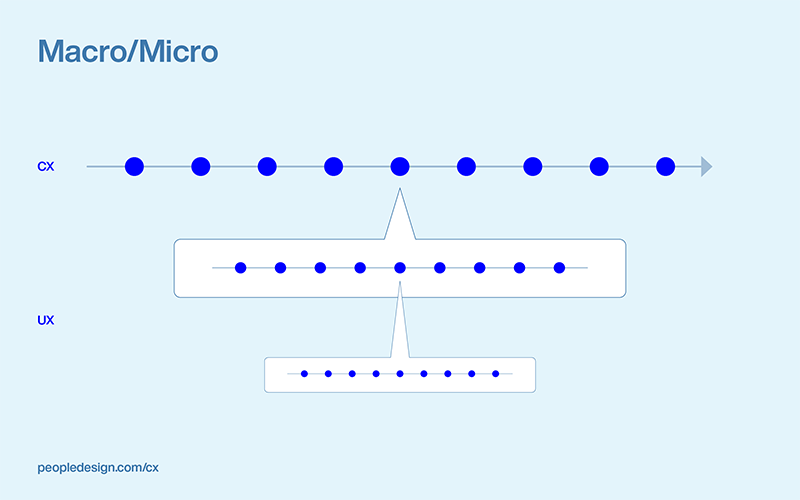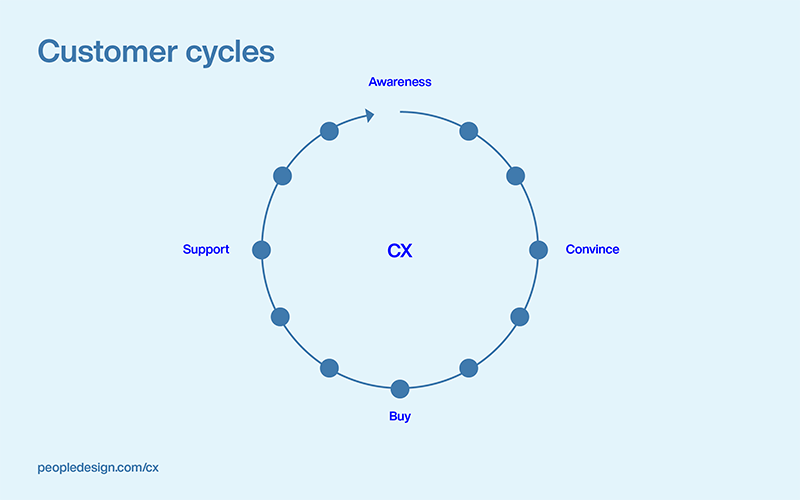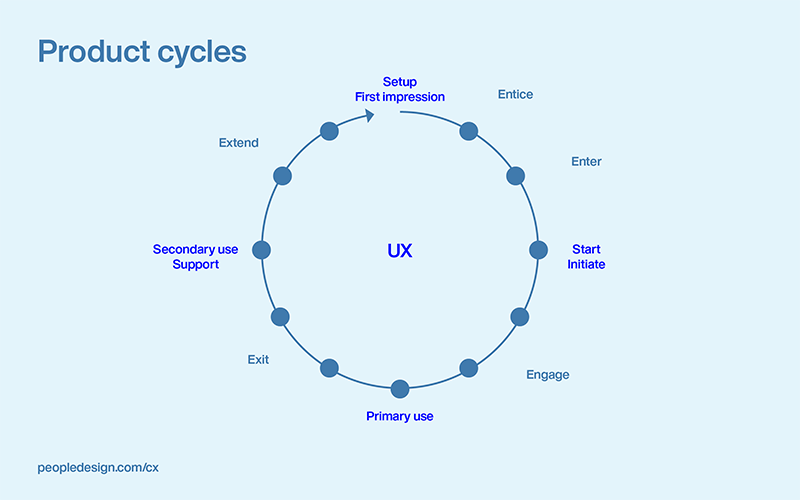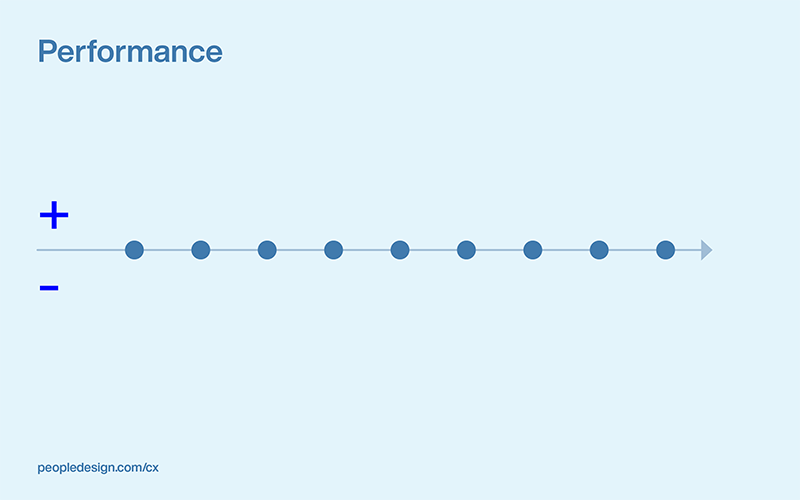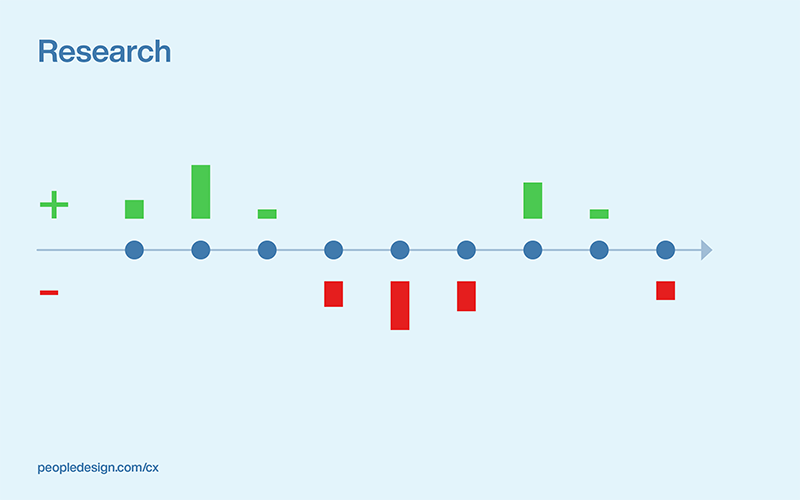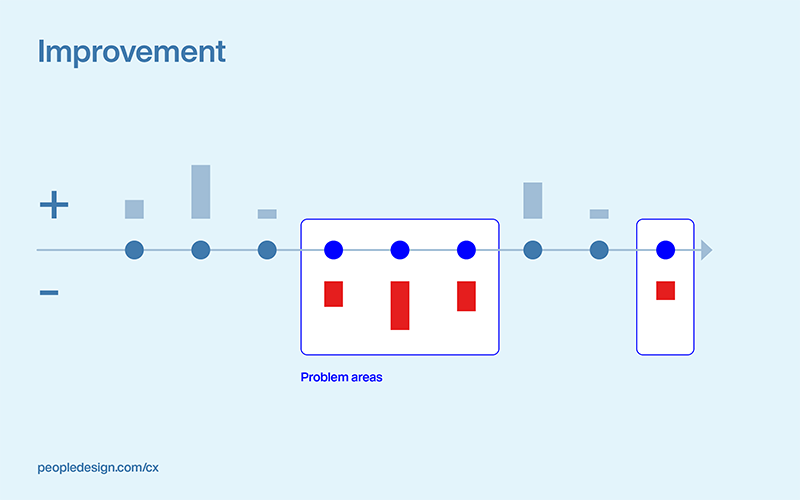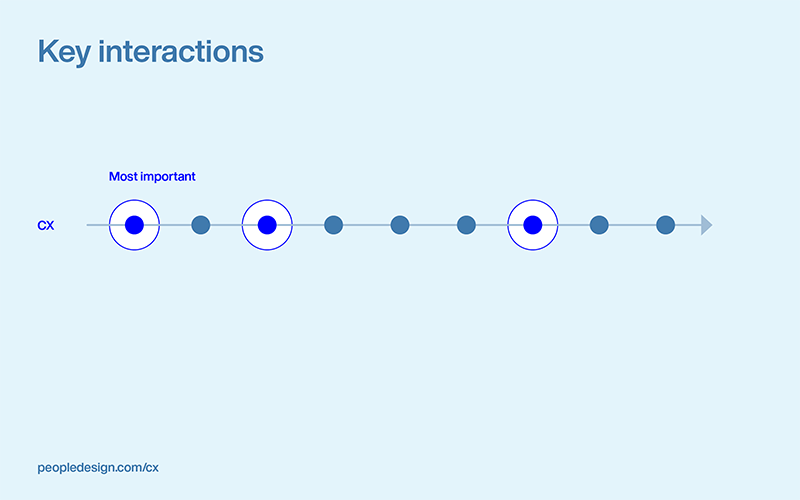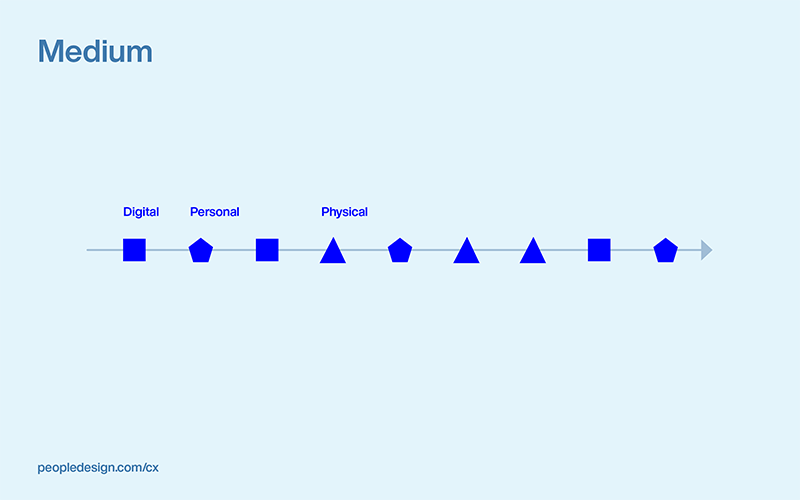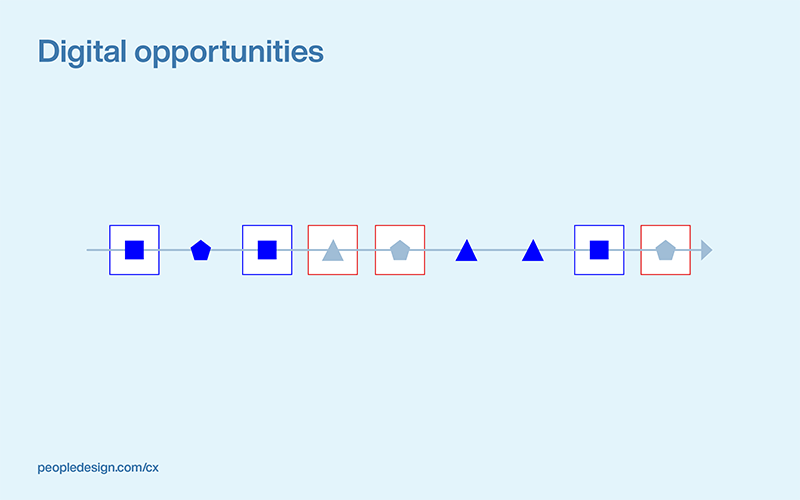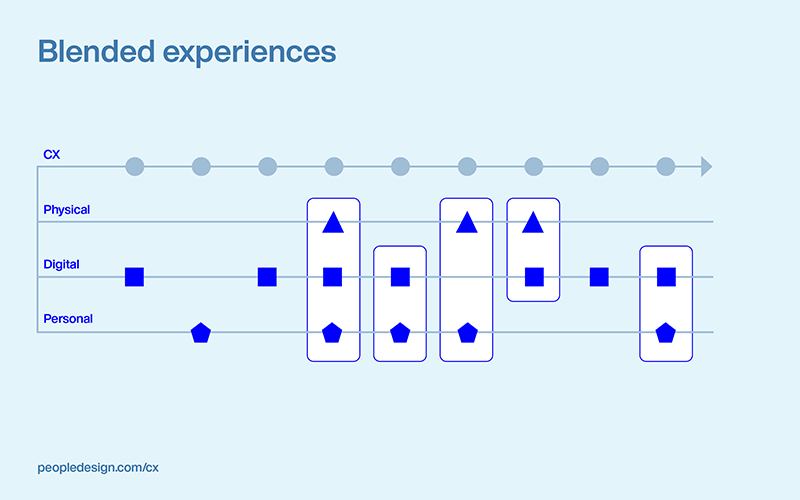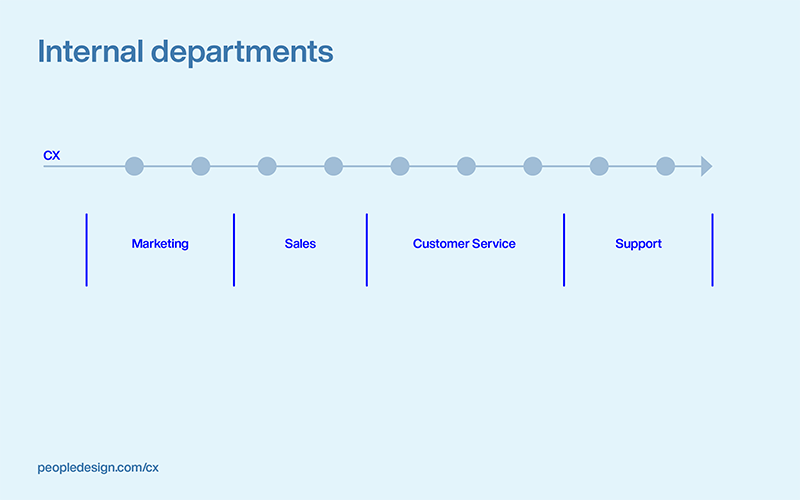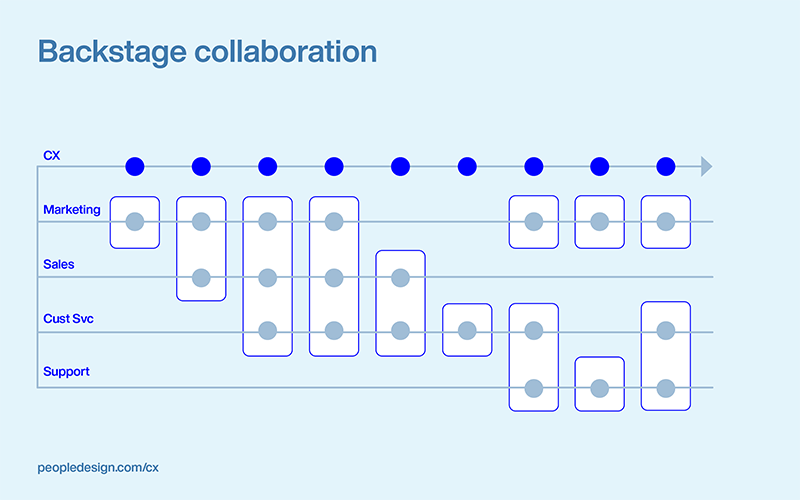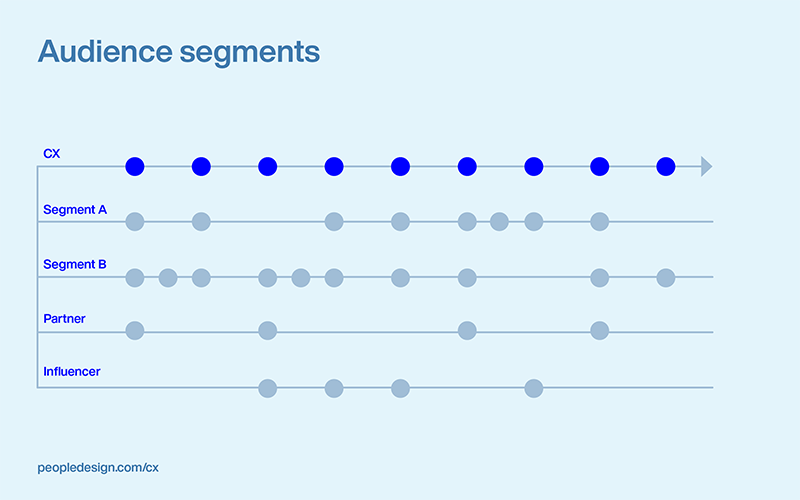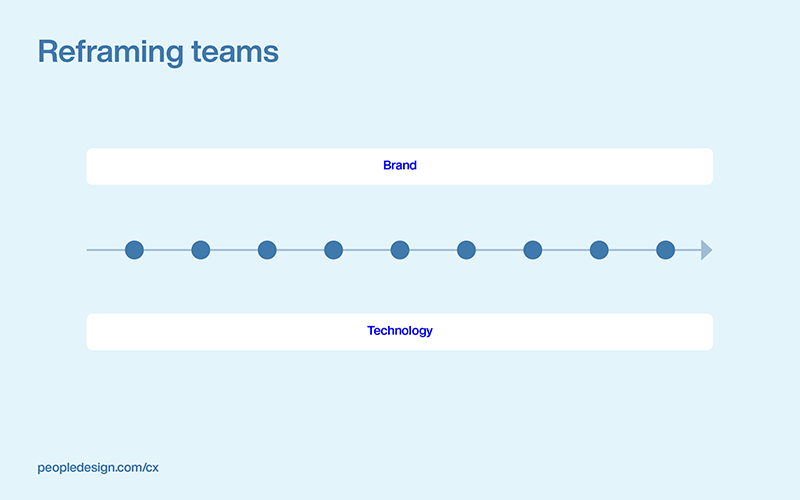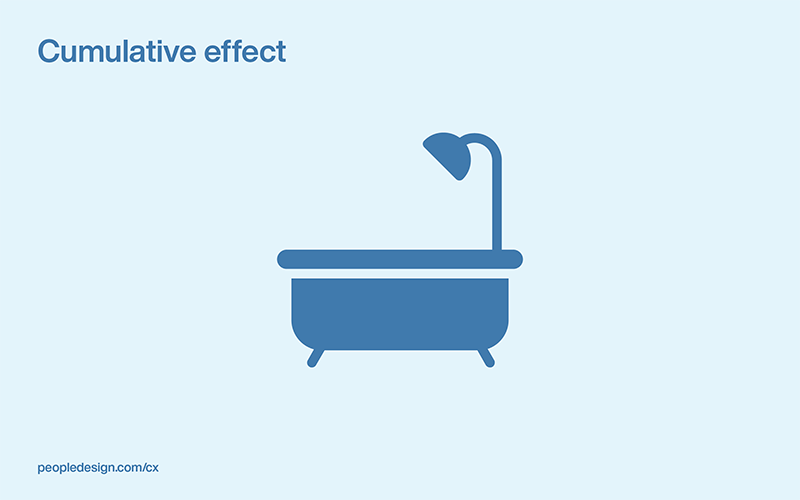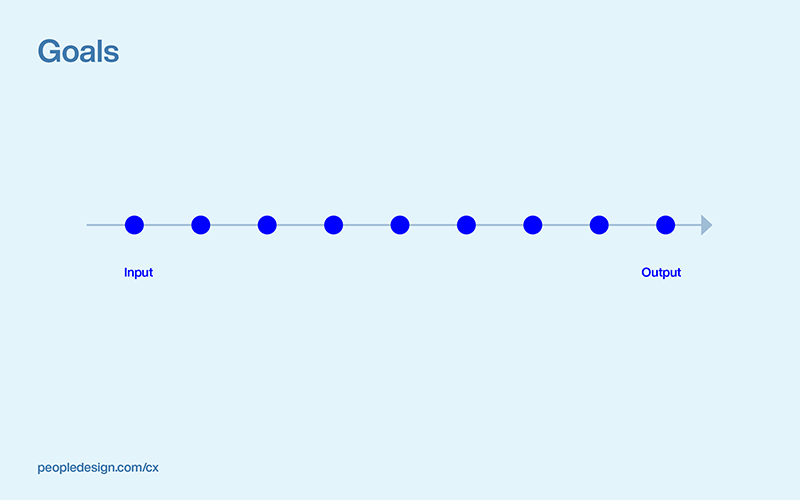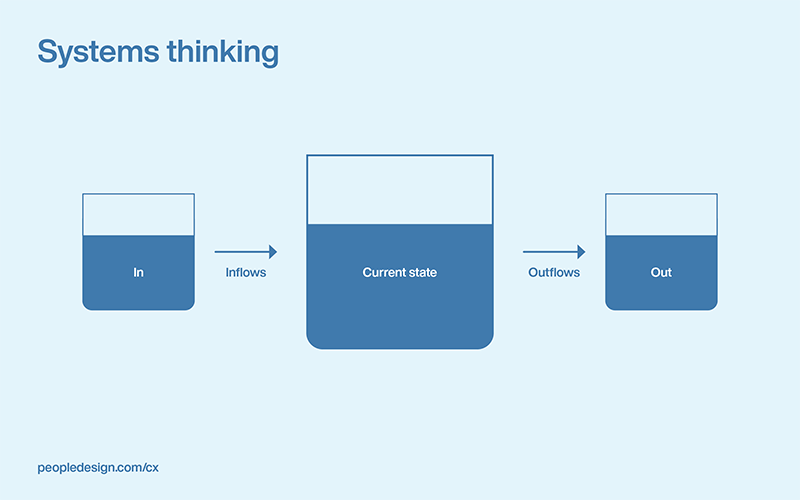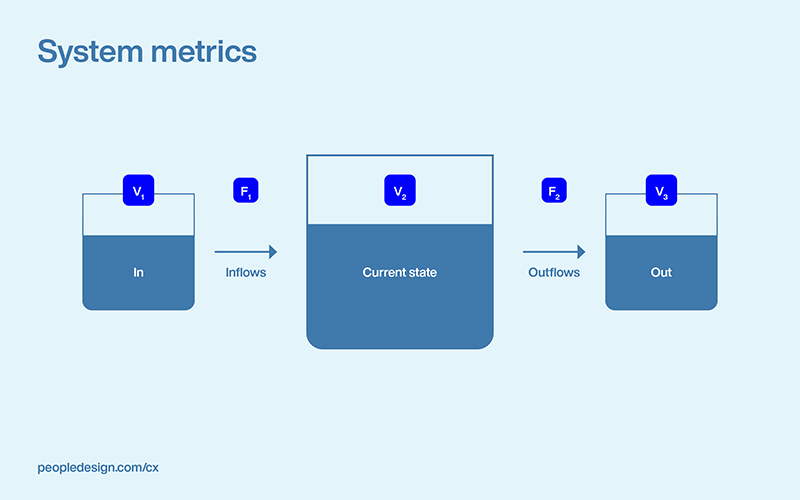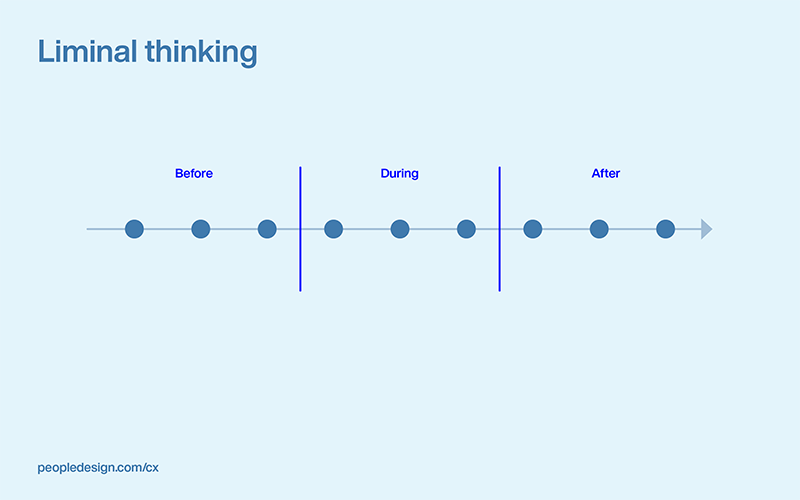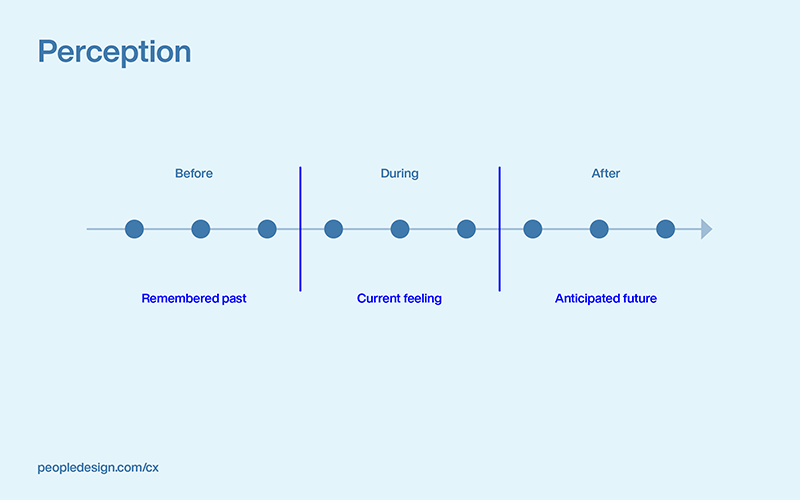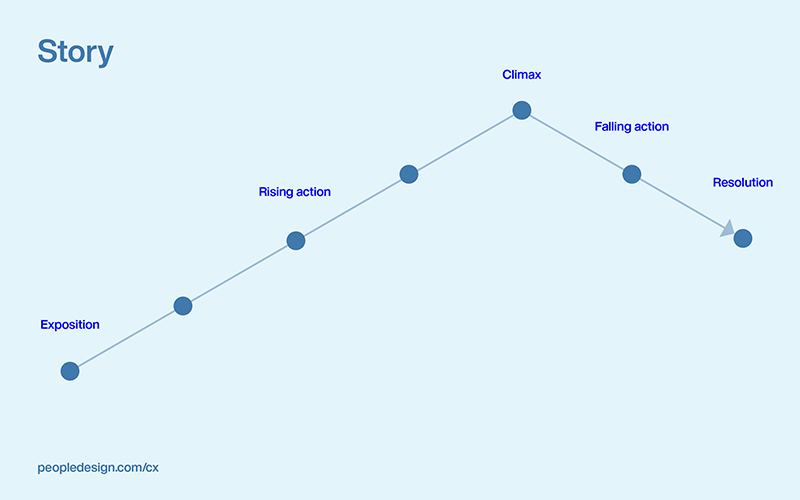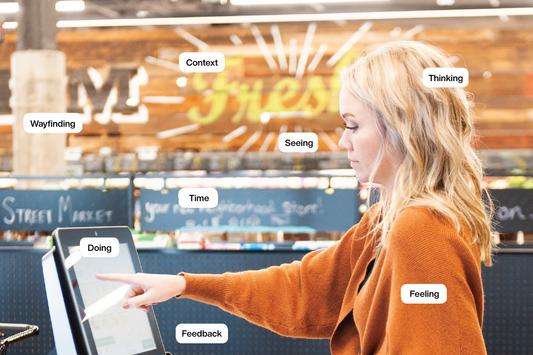
Peopledesign
The Built Environment
Furniture
Lighting
Textiles/Upholstery
Flooring/Carpet
Building Materials
AE Firms
25 Lenses for Experience Design
25 Lenses for Experience Design
Designing for experience is different from designing objects. Any product or artifact has an implied experience, but the experience itself has different dynamics. We don’t actually design a person’s experience; we create opportunities to affect an experience. If we think proactively and strategically about a user or customer experience, we can increase the odds of improving it.
This talk was created for a CX Management Best Practices Symposium sponsored by CXM@MSU.
Consider the scale of experience. Any individual interaction consists of another series of interactions, and any set of interactions add up to a larger picture.
At the highest level, a customer experience may move from awareness to customer retention. Was the customer experience a good one? You can also focus on a product or service offering, a specific engagement, or zoom down to a single button on an app. What happens when I click? Like a camera focal length, dial into the appropriate scale of a CX problem.
For some practitioners, a sliding scale of experience blurs the line between CX and UX. At Peopledesign, we believe there should be a smooth transition from macro to micro experiences. Aligning the biggest things with the smallest makes for a more coherent organization internally and a better experience externally. Simon Sinek advocates this kind of alignment by starting with “why.” Purpose-driven organizations start with why defining the macro picture. But how does it align with what happens on the ground? How does each micro experience build toward our purpose?
Some interactions are more important than others, so not all touchpoints are equal. Business drivers and research may shape your understanding of their relative significance, and it’s good to have a feeling for the critical breakpoints. Knowing which interactions matter most should affect where you focus your energy and resources.
Tide laundry detergent serves as a good example. P&G product managers knew that people generally could not tell if their clothes get cleaner from simple washing. Through research, they learned there were two most significant touchpoints they could address. The first is the box design, which is why we see such bright colors and superlative claims. The second is the way the detergent smells, especially when you first open the box. So while P&G wants you to believe their soap makes your clothes cleaner, you believe it because of the way it smells. They arguably over-engineer the box to be like a billboard, and the smell says: “clean.” Surely they want Tide to clean as effectively as possible, but they understood the key interactions, which were not immediately apparent.
It’s easy to recognize that experiences have different parts. Some interactions are web-based. Others involve a physical location or product. Some of them might incorporate a salesperson or other human. As a starting place, we think about three categories: physical, digital, and personal, which we might visualize as different objects along our timeline.
Digital, personal and physical are broad groupings. Still, it’s a helpful way to move the conversation away from departments or teams (like sales or customer service) with more focus on what’s happening with the customer.
Each medium has different requirements for resources, skill sets, assets, and training. We might think about skills like software and UX when we consider digital experiences. Products and physical environments require skills in materials, prototyping, engineering, and space planning. Finally, personal interactions require people skills such as empathy, presence, and effective communication.
Emerging technology is creeping into all aspects of our lives. Profound changes to how we shop, entertain ourselves, learn, and heal are possible because of technical interventions. Moreover, new technology creates opportunities for new kinds of interactions previously unavailable.
Digital transformation is happening in nearly every industry. Organizations have had a tremendous opportunity to rethink their customer timelines – even before COVID forced them to do so. There are opportunities to lower costs, increase speed through automation, and provide a higher level of service. Just think how we’ve come to expect automated notifications, scheduling, and confirmations.
When considering how digital approaches can enhance interactions, look beyond your industry — benchmark both technology innovation and CX leaders to broaden your view.
Many interactions overlap the physical, digital, and personal. There is often a person working with a digital app to provide services or a physical environment in which this occurs. Chat interfaces are digital interactions, but there is a real person on the other side unless it’s a bot. The role of technology in built environments is being rethought with and without another human.
Blending types of experiences into our timeline creates a complicated diagram, almost like a musical staff. I rather like this because of how business guru Peter Drucker projected the nature of knowledge organization 30 years ago. Drucker believed that next-generation companies would begin to see themselves less like a command-and-control army and more like an orchestra with a conductor and individual specialists contributing in harmony.
Blended experiences will become more the norm as technology finds its way into interactions. Consider what physical, digital, and personal experiences exist today and what could exist tomorrow.
Many organizations envision the customer journey starting with marketing efforts that hopefully lead to sales through customer service and support. A conventional internal view of customer interactions allows for handoffs between these departments. Each has a separate team, budget, agenda, best practices, and metrics. Even when people value CX, it can be hard to break from departmental silos.
Customers don’t know or care who sponsored a touchpoint. Instead, they experience the timeline as a sequence of interactions that build on one another. CX professionals advocate for continuity and aim to cut through departmental differences.
As with blended media, the reality of departmental collaboration can get complicated. We know this is all under the hood and that CX depends on all pistons firing – or at least the right ones at the right times. CX needs an engine, but what customers experience is more akin to the theater. Customers see what’s on stage and anticipate your next act. The show will go on when everything is coordinated backstage.
Many customer interactions rely on interdepartmental coordination. For example, mapping backstage collaboration on a timeline can also resemble a musical staff. Cross-functional teams are not new, but developing a roadmap for how these functions affect CX can lead to better results.
Many organizations appeal to a wide variety of audiences. They may have multiple customer types, segments, vertical markets, not to mention partners or influencers within their market. Some audience segments may require additional touchpoints, while others may skip whole parts of the process based on who they are.
At Peopledesign, we advocate looking at the broad CX timeline, then defining variations. You can develop completely different maps for each type of customer. However, everybody Googles everything, so nearly everyone may eventually visit your public website. Mapping touchpoints can simplify complex interactions. Keep in mind that one touchpoint can serve multiple audiences. Getting clarity here helps develop a cohesive system – no single interaction has to stand alone.
A brand is a perception based on a series of experiences. Creating a system of interactions can affect the perception you're trying to develop in the mind of your user or customer, so all these interactions on a CX timeline are part of your brand.
Technology enables nearly everything that we are doing today. From websites to apps or media in a physical environment, digital interactions are becoming ubiquitous. Technology comes in all forms and provides opportunities to enable interactions.
At Peopledesign, we believe brands are no longer the exclusive domain of marketing, and technology is no longer the exclusive domain of IT. Each has an important role to play all along the customer journey. If we view customer interactions as ingredients with brand and technology as two pieces of bread, a way to reframe teams emerges – the “CX Sandwich.”
Your CX system should have a goal. Each small increment is a piece of the puzzle, but step back and think about the bigger picture. Keep an eye on your larger aim. It might be an audience segment, a product experience, or an overall customer journey, but a system has inputs and outputs. Each interaction along the timeline contributes to an overall picture with an overall effect. Knowing your macro goal can help guide micro decisions.
Here is where our bathtub metaphor comes into play. In Thinking in Systems, Donella Meadows breaks down system design in this way: Water flows in and flows out of the bath. There is a faucet on one side, a drain on the other, and a tub of water in the middle. The bathtub model offers a way to measure and control a system.
Every executive wants metrics. The bathtub metaphor allows us to measure parts of the system. If we identify the three states (inputs, outputs, and current) as volumes V1, V2, and V3, we can also specify the flows (in and out) as F1 and F2. These codes start looking like the game of Scrabble, but it’s a helpful way to isolate individual pieces. Consider how you can adjust your levers and inspire action. If you’re not getting the results you are seeking, adjust flows and volumes.
Taming complexity is a vital part of managing a customer experience. The bathtub model is abstract, but thinking about the components and levers of your system enables you to create a dashboard.
Liminality is about how we perceive time. What is your audience thinking?
Customers aren’t thinking before, during, and after. To an individual, it’s about what just happened, what’s happening now, and what will happen next. There is a lot of interesting literature about memory perception. In his book, Stumbling on Happiness, Harvard Psychologist Dan Gilbert describes how we’re not great at remembering the past or anticipating the future. We’re not even very good at self-assessment – knowing how we feel at any given moment. We’re not as objective as we like to think.
Consider your CX timeline from a user’s or customer's perspective. Forget what happened. What is their remembered past? Forget what you think is happening. How do they feel right now? Forget what you have planned. What are they anticipating will happen next? Your customer's perception is likely different from your internal one. Whether a customer has a good or bad experience can be influenced by their state of mind, what they remember, and their expectations.
We call ourselves Peopledesign as a reminder that people are at the heart of the brand experience. This affects much of the world around us, what we believe, and how we make choices.
Most of how we understand the world is through stories. From campfire myths to blockbuster movies, we think of experiences as lessons, parables, examples. We’re each the hero of our own story and overlay our personal journey onto any experience.
Stories, too, are linear progressions, and the classic story arc is another helpful lens for a CX timeline. Think about your customer interactions as a narrative. Where is the rising and falling action? What is the climax and resolution? It’s a bit like before, during, and after, but in narrative form. Story experts will go deeper into the Hero’s Journey, adding even more layers of meaning to the art of storytelling.
Remember that any user or customer implicitly asks themselves: Where am I in my journey? What clues help me stay on track? What will I have achieved?
Summary
- View the customer experience as a sequence of interactions mapped on a timeline. Timelines are often cycles, with each end as the next beginning.
- Each experience is an opportunity to move a user or customer forward. Consider the performance of each interaction.
- Think about scale, from a macro customer experience or a micro-interaction.
- Consider the medium of each interaction – physical, digital, personal, or some combination of these. Digital interactions are becoming ubiquitous and changing what is possible.
- Consider which interactions are most important.
- Consider how you will address multiple audiences. Which touchpoints are shared or unique?
- Consider what is happening backstage with your internal departments. How will they work together to create a cohesive whole?
- Brand and technology are threads that run through all interactions. When it comes to your teams, think about your CX sandwich.
- Consider the inputs, outputs, and overall goals of your system. Think about what you can measure and change.
- Consider your customer’s perception of what’s going on: What they remember before, what’s happening right now, and what happens after.
- Consider how your experience fits into your customer’s story.
